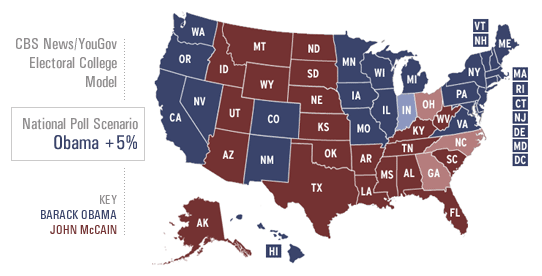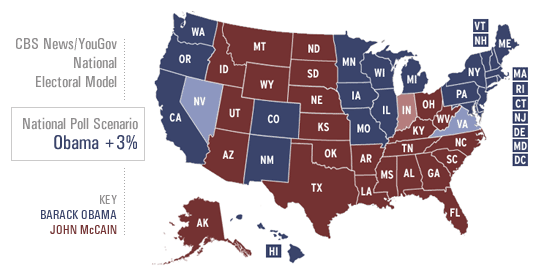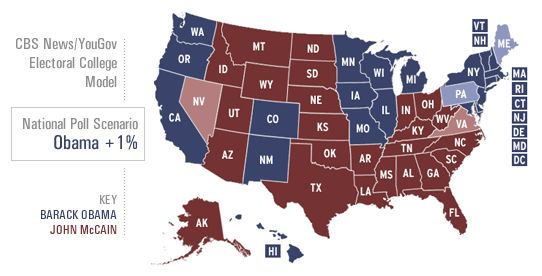What Do Polls Mean Come Election Day?
National polls, including CBS News Polls, can measure the preference of voters nationwide. But the winner in a presidential election is decided by electoral votes accumulated state-by-state. CBS News has partnered with YouGov/Polimetrix to model how shifts in the national horserace numbers would most likely affect the overall electoral vote outcome.
Guided by the results of two previous CBS News/New York Times national polls, YouGov/Polimetrix then modeled 50 state electorates for CBS News, incorporating information from 26,300 online interviews with registered voters.
A CBS News/New York Times Poll conducted September 21-24, showed the Democratic ticket of Barack Obama and Joe Biden with a 47 percent to 42 percent lead over Republicans John McCain and Sarah Palin.
YouGov/Polimetrix applied the 5-point lead to their 50-state national results weighted to each state's relative vote size, demographics, and matched to the CBS News/New York Times Poll in national party identification and ideology.
The 5-Point Lead Scenario
This technique makes it possible to estimate the probability that each candidate would carry any given state - as of now - in a national race. Under the 5-point scenario, the most likely outcome would give Obama 313 electoral votes. There would be almost zero chance of a McCain Electoral College victory if Obama led him by 5 points on Election Day.
Under this scenario, Obama's winning coalition would come from wins in battleground states like Nevada, Virginia, Pennsylvania, New Mexico, Minnesota, Colorado, New Hampshire and Michigan. In this model, he would also carry Indiana. Other battleground states like Ohio would become more competitive for Obama, but most probably would remain in the Republican column. So would Florida.
Obama would hold all the states that voted for Al Gore in 2000 and add five new ones: New Hampshire, Virginia, Colorado, Missouri and Indiana.
Since battleground states might also shift, there are also ranges of possible outcomes. With small shifts in the battleground states, Obama's Electoral College count with a 5-point national lead could range from 313 to 355 electoral votes.
Most likely scenario with a 5-point Obama lead:

The Three-Point Lead Scenario
The state-by-state outcome also shifts with changes in the national margin. At the moment, Obama leads in all national polls. With an Obama lead of only three percentage points nationally, the most likely outcome produced by our model is Obama winning with 302 electoral votes. But he could win as many as 330 or as few as 290.
Since many states are likely to have relatively lopsided outcomes, relatively few states change with changing margins of victory. The most likely scenario for a 3-point Obama victory changes the electoral vote allocation in our model only in Indiana, which would revert back to its more usual Republican status. That would give Obama 302 electoral votes.
Most likely scenario with a 3-point Obama lead:

The 1-Point Lead Scenario
The most likely outcome with the 1-point Obama lead model is 284 electoral votes. But here the range includes a loss (with only 267 electoral votes), or a victory with 304 electoral votes. A close national race - a 1-point Obama win - would also most likely turn Virginia and Nevada back to red, giving Obama 284 electoral votes.
Most likely scenario with a 1-point Obama lead:

What Does It Mean For The Candidates?
As CBS News senior political correspondent Jeff Greenfield reports, if you figure Obama has a 5 point national lead (and as of Oct. 1 poll, it's 9 percentage points) and apply that on a state-by-state basis, you find that Obama holds all of the states John Kerry won in 2004, plus Virginia, Iowa, Missouri, and three states from the interior West where Republicans usually run strong. That way to win includes Colorado, New Mexico and Nevada, a shift that gives Obama 302 electoral votes - 32 more than the magic 270 number. Design your own "Ways to Win" on an interactive map right here.
As Jeff Greenfield noted on the CBS Evening News, there are recent state polls that offer a similar picture.
"Looking at recent state polls, it's not good news for McCain. Obama is statistically tied, or even ahead, in North Carolina, Florida (which decided the 2000 race) and Ohio (decisive in 2004)," Greenfield said.
How The CBS News/YouGov Model Works: The national horserace percentage is not distributed evenly across all states. States differ in size (how much they contribute to a candidate's national vote total) registration, turnout, demographics and partisanship and, of course, candidate preference.
To model these state-level differences, we incorporated 51 additional sets of interviews with voters conducted by YouGov/Polimetrix, matched to voter registration lists, partisan and demographic profiles in each of the 50 states and the District of Columbia, and which were then adjusted to reflect the latest national CBS News/New York Times poll horserace estimate. Using all these data, each state was assigned a probability of going to either Obama or McCain.
The electoral tallies and maps are a model of the Electoral College's most likely outcome if a candidate were to win the national popular vote by 5 percent, 3 percent, or 1 percentage point. Because some states shape up as closer contests than others, a shift in national vote choice will mean a change in the likely winner in the close states more readily than in less competitive states.
YouGov/Polimetrix selected respondents for this modeling from its online panel of 1.1 million Americans. They were matched to a sample of registered voters from each state to ensure representativeness.
As the campaign goes on, the underlying pattern of results could change state by state. CBS News will again look at the state by state implications of the national polling numbers at later points in the campaign.